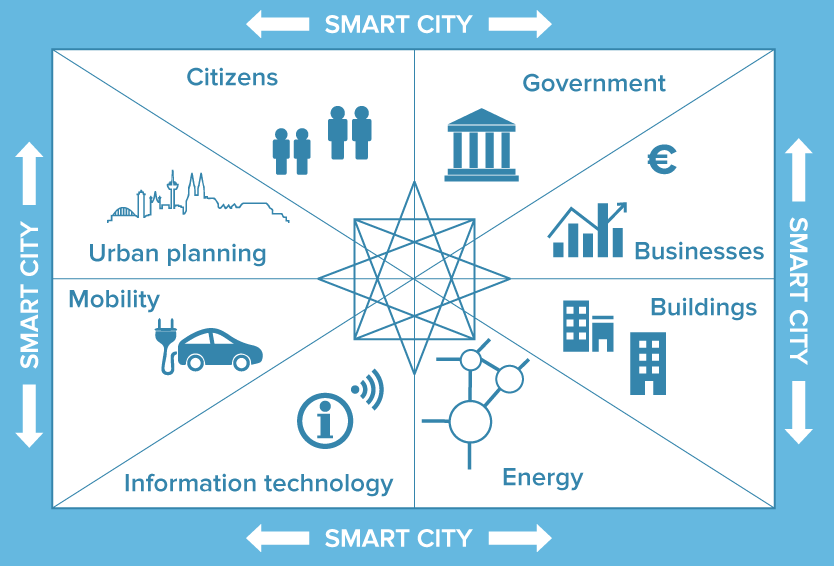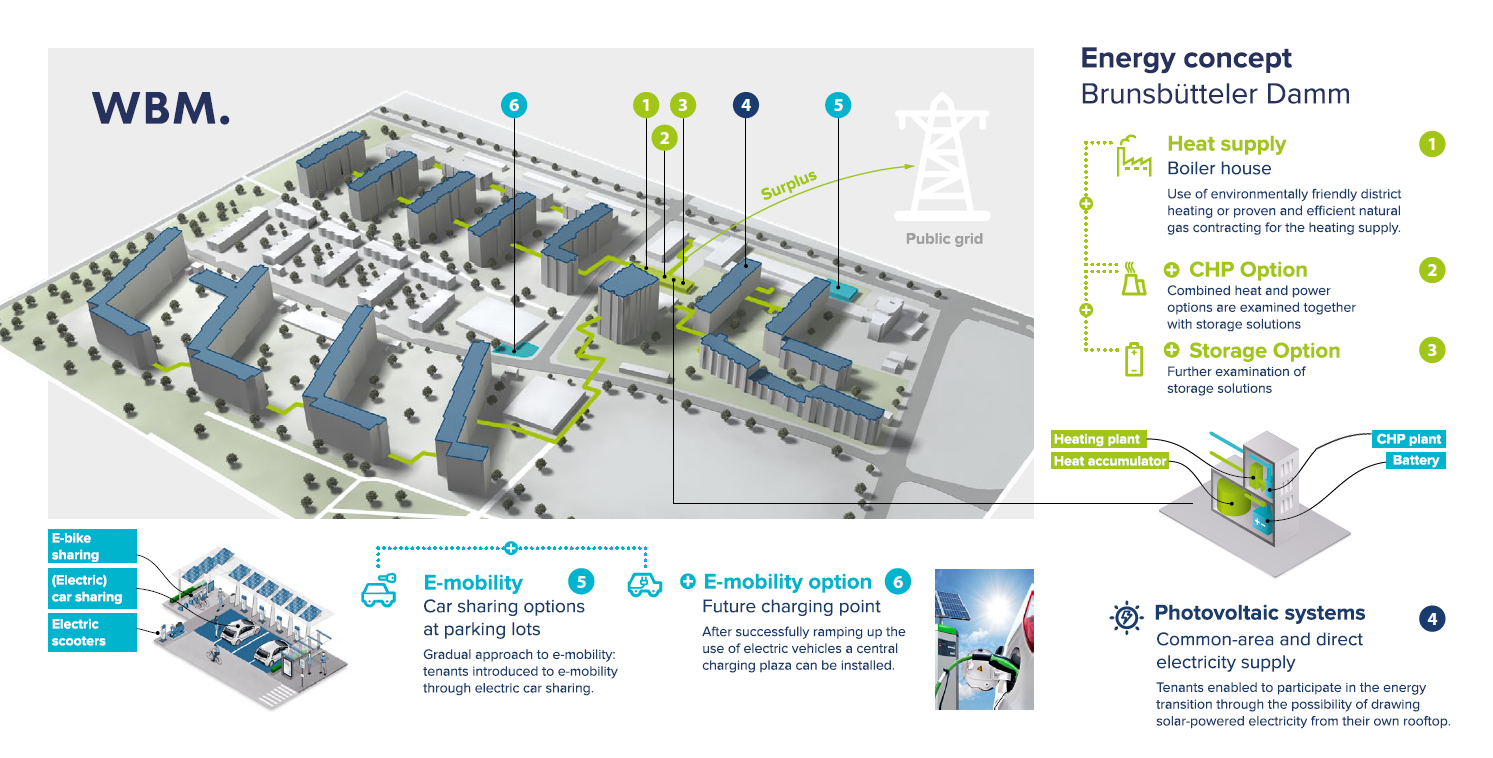Energy-Efficient Neighborhood Development in the Smart City Context
Smart cities and energy-efficient neighborhood development
What does a neighborhood on the outskirts of Berlin have to do with the steady rise in digitization? At first glances, not much. But take a closer look and you will see certain overlaps. The advancing pace of digitization has long been one of the megatrends of the 21st century, and it is one that is growing in importance. Modern information and communication technologies enable us to capture and process data much faster now. This in turn generates a digital, connected data basis for other technical solutions. Which creates the potential for optimization and automation in almost all spheres of life. These disruptive technologies enable innovative business models and facilitate an increased degree of flexibility and individualization. This is why digitization is often considered to be synonymous with the fourth industrial revolution or Industry 4.0.
But what does this have in common with urban development and the smart city? Quite a lot, as it turns out, given that digitization is instrumental in the development of a sustainable city. Cities have a great many different challenges to face on a daily basis. If these are to be overcome, the city infrastructure needs to be effective and it needs to function efficiently. Incorporating innovative, digital technologies in the urban system makes cities better able to fulfill their role.1

Figure 1: The smart city approach
The smart city approach (Figure 1) is a strategic innovation concept which aims to overcome the future challenges facing cities in the environmental, social, economic and cultural sphere.
The objective is to apply smart technological solutions. Problems can arise for cities through constant population growth, bringing with it for example an increased demand for housing, the need for a different way of using resources (water, energy, data) and a greater requirement for mobility and infrastructure modifications. Our aging society and the structural transformation of our cities are issues that will grow increasingly relevant as time goes by.
So how can all of these problems be resolved? One aspect involves cooperating across areas and across government departments, which is what the smart city approach aims at. The goal is to drive the development of potential solutions. It is going to become increasingly important for cities not only to sustain but successively to improve the standard of living for their residents on the basis of the same or even fewer resources. The key objective of the smart city approach is therefore to optimize public services long term by means of smart urban management and the technologically assisted cooperation of public authorities, municipal enterprises and social agencies. This also involves conserving resources by making use of renewable energies and achieving increased levels of efficiency in this context.2 How can these theoretical goals be achieved in practice? A first step is to realize the ideas in one neighborhood of the city. The development of neighborhood concepts is one contribution toward the operational delivery of the smart city mission in respect of saving resources. Buildings being a significant factor in a city’s energy and resource consumption, the way in which neighborhoods are supplied with energy can help resources to be conserved and used more efficiently if innovative solutions are applied in the form of holistic concepts, which might for example involve the use of combined heat and power (CHP) or solar power. Innovative technologies allowing people to generate their own electricity or facilitating energy savings and efficiency enhancements can be piloted at the neighborhood level.3
Project outline
A practical example can serve to illustrate the potential of energy-efficient neighborhood concepts. In collaboration with RITTERWALD, the housing association “Wohnungsbaugesellschaft Berlin Mitte” (WBM) had some 2m EUR to invest in developing an innovative energy supply concept for a neighborhood in Spandau, a district of Berlin. The estate was built in the 1960s and is located on the outskirts of the city off the major thoroughfare of Brunsbütteler Damm. The neighborhood consists mainly of multistory residential buildings (approx. 1,700 apartments) and can accommodate 5,000 people.
The main objective of the energy-efficient neighborhood concept was to guarantee the supply of heat and power for the apartments connected to the grid, and to optimize consumption levels. The possibility of realizing environmentally friendly and cost-effective power and heat supplies was an aspect to be examined in the process. Smart mobility concepts like electromobility and car sharing models offer added value for the tenants, as do new technical possibilities in the field of submetering services. Another factor that had to be considered in planning the energy-efficient neighborhood concept was the work currently under way on the buildings themselves. The apartment buildings were currently being successively renovated, with much of the work still remaining to be done. The government’s “Stadtumbau West” subsidy program for the west of Berlin, where this neighborhood is located, also had an influence given that there were plans to increase the density of the estate by adding a further 100 or so apartments. These apartments had to be taken into consideration in any energy supply concept.
Energy-efficient neighborhood concept
The energy-efficient neighborhood concept that was ultimately developed (Figure 2) combines various different components falling under a number of interdisciplinary topics to arrive at a holistic solution. Each topic cluster involves various options, each of these in turn incorporating innovative technologies.

Figure 2: Components of the energy-efficient neighborhood concept
Heating supply
One of the key concerns for residents is their heating supply, security of supply being uppermost in their minds. The average heat consumption in the years 2013 to 2015 was 16,705 MWh per year. Heating is currently provided by a gas-fired heating plant transporting the heat through a 2.8 km network of piping. But with the existing supply agreements expiring at the end of 2017, a new solution to maintain the estate’s heating supply needs to be found. There are several possible variants:
A conventional solution would be to connect the neighborhood up to the heating grid operated by the local district heating supplier. To do that, however, a new network of pipes would need to be installed (approx. 2.7 km long), which would necessitate about 2m EUR in investments. The key risk to the neighborhood’s security of supply would center on whether or not it was possible to connect the estate up to the district heating system in time. The neighborhood’s heating pipes, which are currently owned by WBM, are earmarked for transfer to the district heating supplier in the course of connecting the estate up to the latter’s heating grid. District heating could cut the estate’s annual CO2 emissions by about 1,000 tons.
Another option would be to enter into a heat contracting agreement involving the use of the existing central boiler house. Here, too, the plan would be to transfer the heating pipes to the contracting company. Biogas could be used as an alternative to conventional fuels in this scenario. This would incur additional costs, however: a 10% biogas admixture would raise the price of the heating by about 10%. That said, operating the heating system on biogas would reduce the annual CO2 emissions by about 1,400 tons compared to operating it on natural gas.
Operating distributed heating plants under a heat contracting model could significantly reduce the length of piping required for the heating system and with it the extent of the heat loss. This would save some 500 tons of CO2 per year.
Wood pellet heating plants operated under a contracting model represent another innovative supply solution. The network of heating pipes is transferred to the contractor in this model too. But operating a pellet heating plant is a relatively complex business. A pellet storage facility would need to be built in to the cellar of the current boiler house. Besides the investment costs for building the pellet store, the operation of the plant would produce higher fine particulate emissions and noise pollution from the weekly delivery of pellets. The considerable cost of maintenance and servicing, as well as the fact that an operator would always need to be present, would substantially increase the heating price. Nevertheless, the use of wood pellets as a renewable fuel makes good environmental sense. Compared with operating a heating plant on natural gas, this option would result in about 2,000 tons lower CO2 emissions per year.
Combined heat and power plants (CHP) are another option for producing heat cost effectively. However, the plant does need to be operated above a minimum level. Because the neighborhood in Spandau would require no more than about 2,500 hours of full utilization from such a plant, CHP is not considered an economical solution in this case.
Electricity supply
Another of the energies that needs to be supplied is electricity. In the period 2013 to 2015, the average electricity consumption across WBM-owned properties amounted to 466 MWh per year to supply the estate’s common-area electricity needs and required heating output. The residents’ private consumption amounts to some 6,205 MWh per year on top. There is considerable potential here to establish a direct electricity supply model (known as “Mieterstrom”).
A solar power solution on a medium scale could cover the neighborhood’s common-area electricity need. The amount of roof space available for photovoltaic (PV) cells would need to be examined. The renovation work that has already been carried out has seen the addition of some rooftop technical structures, thus reducing the amount of usable space. About 40% of the roof space is currently available to use for the generation of solar power. Across the whole neighborhood, this amounts to a total area of some 8,000 m2. The realization of a medium-scale PV solution in the form of an operator model would result in no further investment costs for WBM. An installation of this type could cut annual CO2 emissions by around 70 tons. That said, it would make better environmental and economic sense to install a PV system to generate direct electricity for the tenants as well.
A large solar power solution could both supply the estate’s common-area electricity needs and cover the tenants’ direct electricity requirements. But it would necessitate installing photovoltaic cells on every inch of usable roof space across the estate. An operator model would avoid any additional investment costs in this scenario too. The electricity would be sold in a direct electricity supply model and marketed to the tenants as a separate brand. The tenants could therefore benefit from low-cost renewable electricity. For customers buying WBM-branded electricity the price would be about 2ct/kWh below the general tariff (28.48 ct/kWh). It would, however, be necessary to gauge the tenants’ interest in the direct electricity supply model in advance. A penetration rate of 30% of the tenants on the estate would be necessary to break even with the direct electricity supply model. A large solar power solution which could also supply the tenants offers a potential CO2 saving of about 570 tons per year.
Storage batteries are an aspect that should at least be considered for both of these solar power solutions. Though such battery solutions are not yet profitable at the current time, this could change in the future.
Electromobility solutions
The incorporation of mobility solutions into the neighborhood concept would offer tenants considerable added value. Electromobility may be a somewhat marginal subject at the present time, but its importance is set to grow. It is the government’s objective to increase the penetration of electromobility and to promote it to such a stage that the number of electric cars in Germany reaches 1 million by 2020 and 6 million by 2030.4 This is undoubtedly an ambitious goal, but it is important to discuss how the subject can be tackled.
Providing charging point infrastructure within the neighborhood would be an easy way to enable interested tenants to make use of electromobility options. WBM would need to sign a contract with suitable providers to install one or several charging points on semipublic land within the estate. Preparations could even be made today for a future centrally located charging plaza by installing empty conduits or cables at the same time as the heating pipes are being renewed.
A fixed electric car sharing point is a good way of allowing tenants to test electric cars and protect the environment at the same time. In order to install and operate a fixed car sharing point, WBM would need to sign an agreement with a car sharing provider, who would then provide electric vehicles for the tenants to use. Operating a fixed car sharing model with electric vehicles could achieve annual CO2 savings of around 10 tons per vehicle.
A fixed electric bike sharing point would be another alternative electromobility solution, which would also target a broader selection of tenants. Like the car sharing option, there would be a contract between WBM and a provider for the installation and operation of an electric bike sharing model. The cost would be refinanced through the rental price for the vehicles (2 – 3 EUR/h). Both sharing models could be initiated as a pilot project and scaled up as required.
Submetering services
Submetering is an area where digital technologies can be particularly well employed. What submetering involves is the taking of meter readings to measure the consumption of heating and hot and cold water in the individual apartments. Cutting-edge metering technologies were also examined as part of the energy-efficient neighborhood concept.
Maintaining the status quo in respect of metering technologies already installed in the apartments represents the lowest-cost option, but this is not recommended from a long-term perspective. The meter reading process and the transparency of the resulting data is less good with conventional meters than it is with radio equipped devices. Advances in digitization make it highly likely that radio metering devices which report readings autonomously and transmit them via the Internet will become standard in this area.
Retrofitting the existing meters to work with radio technology would simplify the meter reading process and create the basis for rapid data capture and easy management of energy data. For an energy management system to be successfully established, the metering devices need to be capable of providing extensive data on energy consumption, energy production and quality of energy. Good device interconnectivity is necessary to control the different components.5 With an energy management system in place, a reduction in annual energy consumption can be achieved. Modifying the metering devices to work as radio meters is the necessary basis for implementing an energy management system of this kind.
Summary
With the smart city approach as a general blueprint, each component of the solutions examined above makes a contribution to a sustainable energy concept. The outlined technical solutions can be implemented within different potential configurations of the neighborhood concept. Even if the estate was still connected to the conventional district heating grid but innovative solutions were applied such as a PV-based direct electricity supply to the tenants or an electromobility solution within a fixed car sharing model, the total annual CO2 savings could amount to as much as 2,400 tons. 42% of this annual CO2 saving would come from the modernization of technical systems and heating pipes. Supplying tenants with solar-powered direct electricity would cut total CO2 emissions by 24% and renovating the existing buildings would reduce it by a further 33%. Electromobility in the form of electric car sharing would offer a 1% saving of annual CO2 emissions in its present dimension as a pilot project for the tenants. The renovation of the buildings and modernization of the heating pipe network also offers considerable potential to improve heat consumption across the neighborhood. Total heat consumption, which currently averages approx. 16,700 MWh per year, can be reduced by about 27% through renovation and modernization measures alone. Further savings potential could result depending on the technology used to generate the heating power.
Contact
Do you have questions regarding this topic? Please contact:
-
 Dr. Mathias Hain
Dr. Mathias Hain-
email hidden; JavaScript is required
-
email hidden; JavaScript is required
1 Cf. Etezadzadeh (2015), 45 ff.
2 Cf. Senatsverwaltung für Stadtentwicklung und Umwelt (2015), 3 ff.
3 Cf. Hoppe (2015), 10 f.
4 Cf. Lorkowski (2013), 116.
5 Cf. Lorkowski (2013), 116.
